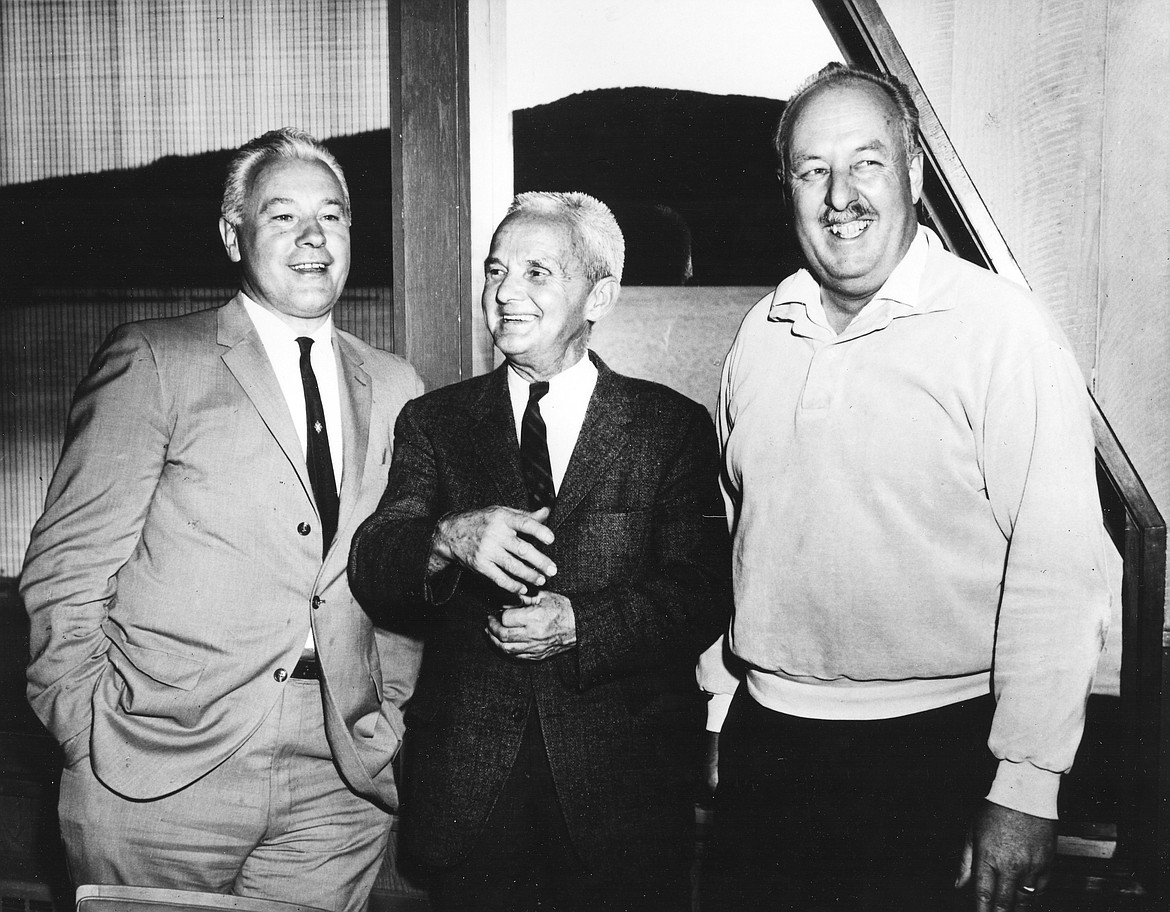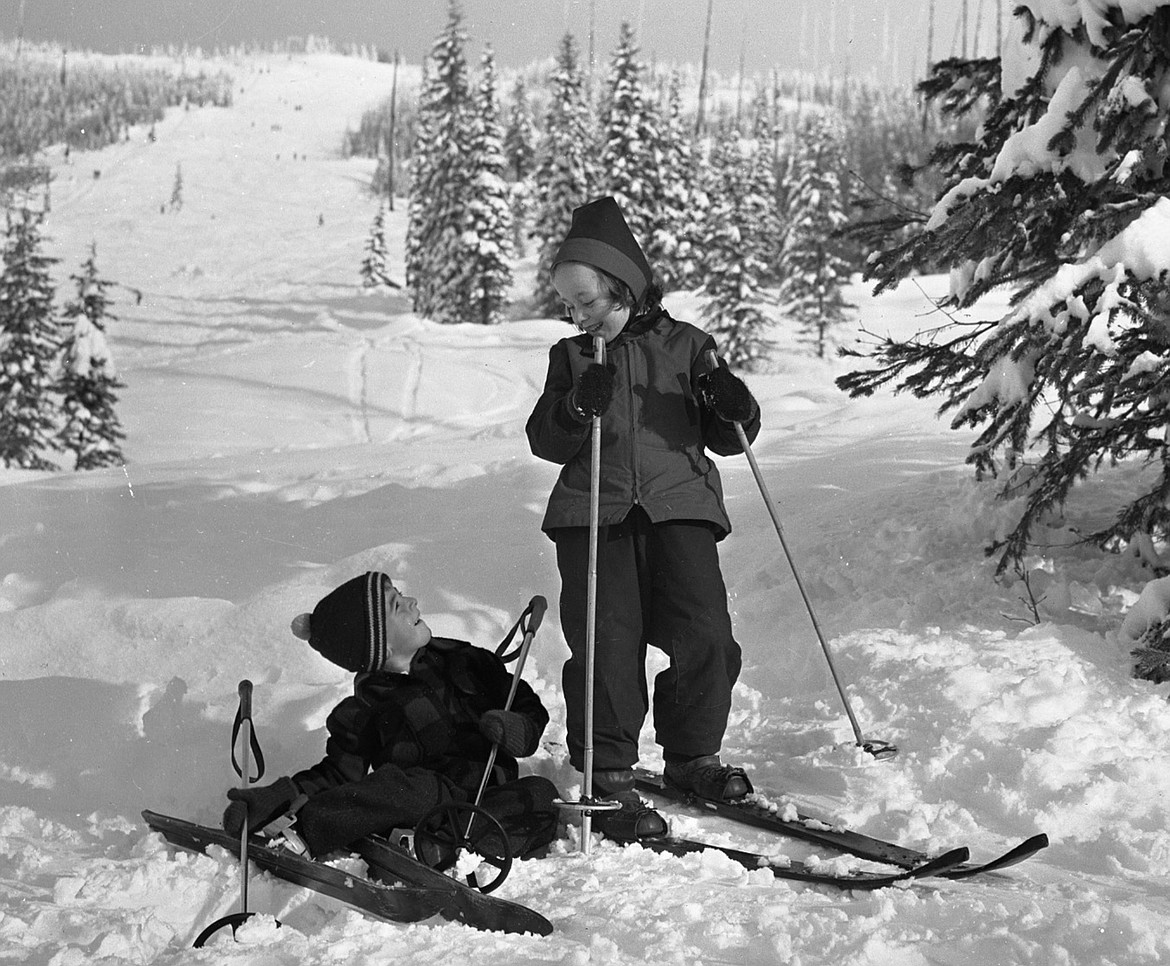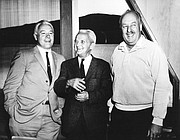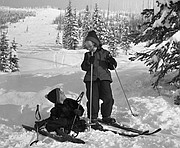Celebrating 70 years of skiing slopes on Big Mountain
On Dec. 14, 1947, the Big Mountain ran its lifts for the first time, taking skiers up the mountain at the low price of $2 per lift ticket.
Seventy years later, the mountain is thriving. Whitefish Mountain Resort is heading into this anniversary season following a record year in total visits, passholder visits and a near-record year in accumulated snowfall.
The mountain now is a far cry from its modest genesis, which saw decades before even bringing shareholders a return on their investments.
Humble beginnings
Since the beginning, the mountain has been about community.
Prior to the resort starting in 1947, skiing on Big Mountain was done by members of the Hellroaring Ski Club and others who traveled the strenuous uphill to get their turns in.
The first building on the mountain came in 1935, when the ski club installed a warming cabin. Traffic picked up the following year when Lloyd “Mully” Muldown became the first coach of the Whitefish High School ski team, and by 1939 a rope tow had been installed on the mountain.
The real possibility for a ski resort in Whitefish was explored in December of 1940, when Al and Grace Carter Lindley, both members of the 1936 U.S. Olympic Ski Team, came to Whitefish with the mission to survey the area for the Great Northern Railroad.
Lindley sent back favorable findings on elevation, slope gradients, length of runs, average season statistics and accessibility information for Big Mountain. In the same year, Charles Creon and Lyle Rutherford set up a rope tow on Hellroaring Creek and a racecourse to go with it. That course brought the Northern Rocky Mountain Ski Association Championships to Whitefish in February 1941.
Progress on the mountain stalled when World War II broke out, with skiers using their abilities in the war efforts rather than on the mountain. Karl Hinderman, who would later become owner and operator of the ski school, was in charge of all U.S. Ski Troop activities at an army camp on Mount Rainier in Washington.
Hinderman and Ole Dalen were sent to the Italian Alps with the 10th Mountain Division and saw action in four campaigns in the Apennines and Po River valleys. Dalen lost his right arm to shrapnel wounds, but he kept on skiing once he returned to Whitefish.
After the war, the Whitefish Chamber of Commerce started getting serious about becoming a winter tourism destination.
Getting started
In January 1947, Carl “Ed” Schenck and four Whitefish men headed up the mountain to scout its potential for a ski resort. Schenck was a veteran of the 50th Parachute Infantry during the war, a ski lift salesman for Constam Engineering Co. in Great Falls and a member of the National Ski Patrol prior to moving to Whitefish.
A ski resort seemed a perfect way to boost the town’s economy, which at the time was primarily dependent on the railroad.
Alongside colleague George Prentice and the Whitefish chamber, Big Mountain was conceived.
Prentice and Schenck brought in their own investment of $20,000, and the chamber raised $40,000 for the mountain. Winter Sports, Inc. began on March 31, 1947, after $70,000 of stock went for sale at $100 and $200 a share.
The resort opened for the first time on Dec. 14, 1947 with a T-bar and day lodge. A total of 6,900 skiers visited Big Mountain that year, and WSI lost $3,600.
Schenck wore a variety of hats at the resort, serving in roles from office manager to snowplow patrolman. One year, he later recalled, his total salary amounted to $1,300.
While Prentice moved on after the resort got started, Schenck stayed on, serving as Big Mountain’s general manager from its early years until he retired in 1979. He stepped down as president of the Winter Sports, Inc. board in 1980.
Mike Muldown, son of Lloyd Muldown, said Schenck was the backbone of the resort in the early days.
“Boy, he held her together,” he recalled last week.
In its early years, the resort struggled, and many feared they’d invested in a hopeless cause. Understanding the importance of the railroad, Schenck got the Great Northern Railroad to set up an advertising campaign featuring the resort.
Tim Hinderman, son of Karl Hinderman and executive director of the Flathead Valley Ski Education Foundation, said without the railroad, the resort might not have found success.
“The original ability to grow a bit of a destination clientele on the Great Northern Railroad between Minneapolis and Seattle I think was a mainstay,” Hinderman said. “Without that, I don’t think there would’ve been any way.”
Despite its meager number of runs and lodging facilities, WSI bid to host the 1949 National Downhill, Slalom and Combined Championship Ski Races, bringing on Austrian skier Toni Matt in fall of 1948 to help design courses.
Matt gave the mountain credibility, Muldown remembers. A respected-skier, his presence on Big Mountain made other skiers across the country take the little hill in Montana seriously.
As a kid growing up on the mountain, Muldown said he remembers looking up to Matt.
“Toni Matt was one of the most charismatic people you’d ever meet,” he said. “He was just an amazing presence on the mountain, he gave it credibility. I’d spend my time sitting in the corner of the original ski shop listening to him.”
By 1950, someone visiting Whitefish could get a two-bedroom cottage in town for $30 a month, and day passes dipped as low as $1.25 on the T-bar lift. As soon as 1955, however, Big Mountain was advertising ski instructions by world champion Matt and summer chairlift rides up to the summit. That winter, the mountain also hosted the Junior Nationals.
Among the 150 boys and girls competing, hometown hero Martin Hale grabbed the overall boys title. Hale, 17, finished second in the downhill and slalom and tied for first in cross-country, enough for the overall first.
At the start of the decade, the mountain could barely get a line of credit from merchants in town, and places like Olney had yet to incorporate electricity. By the end of the 50s, however, Whitefish had television and its own telephone switchboard, and Big Mountain had power lines, new runs and an $8,000 Turner SnoCat that could drag a dozen skiers up the mountain.
Mike Muldown was on the hill on opening day, but at just 2-years-old then, he remembers growing up on the mountain during the 50s much better.
“I was lucky enough to be there in the 50s,” he said. “We were there all the time, it was a small group, that mountain culture. It was nowhere near what it is now, obviously, just a real small group of people who were ski advocates. I was up there all the time.”
Likewise, Hinderman remembers the freedom he was granted as a child exploring the mountain.
“That was my first ability to go off and do something by myself — at age 5 — so I remember the freedom, and being in that environment, which is such a friendly environment anyway, even for parents today,” he said. “As soon as the kids are capable of skiing around the mountain, they’re basically off doing it.”
“It was a neat way for me to experience that.”
Things were looking good for the expanding resort heading into the 1960s.
Growth spurts
The construction of Chair 1 drove the mountain — and its skiers — to new heights.
For the first time, skiers could ride a modern chair lift 2,000 feet to the summit and ski seven days a week. With the new electric powered, 117-chair, 31-tower lift, the resort could now accommodate up to 1,000 skiers per day.
Among a host of milestone improvements on the mountain, Chair 1 might be the most crucial, Hinderman said.
“That’s probably the most pivotal change in the history of the mountain, in my opinion, just because if you look at where they were skiing before that and then when they were skiing after that, the mountain grew four or five times in skiable acres and doubled in vertical,” Hinderman said.
The new lift put Big Mountain on the map with other world-class resorts, and just two years later the mountain was host to the 15th annual National Alpine Junior Championships.
That same year also saw a $65,000 lodge remodeling project to provide accommodation for 150 skiers in the east wing, including deluxe rooms with private baths, dorms and bedroll facilities. In the west wing, skiers could use a new dining room, cafeteria and an updated Bierstube.
Along with lift and facilities expansions, skiers on the mountain also began pushing into the backcountry.
The out-of-bounds policy was changed in the 70s, partly because skiers would go off-trail regardless of the rules, and a new generation of free-heel and tele-skiers took to the mountain in the 1970-71 season. Locals Bob Conat, Tom Eisinger and Toni Hinderman and Colorado skier Rob Roy brought Nordic technique to the ski patrol, and Hinderman’s father, Karl, revived telemark techniques from his old Army ski manuals. All the while, WSI added new lifts, replacing the PomaLift with Chair 3 and installing Chair 4.
By the mountain’s 25th anniversary, it was clear how much progress had been made. The 1971-72 season saw about 218,000 total visits, and gross revenues had increased from $11,200 in the first season to $1.1 million. Payroll jumped from $7,500 at the start to $396,000, and by 1976, stockholders saw the first returns on their initial investments.
The 80s saw more big changes on the mountain.
New high-tech materials, fiberglass skis and brightly-colored synthetic fabrics changed the look and pace of the mountain. The long-awaited Summit House was completed in 1985 and expanded to 15,700 square feet just four years later.
Even bigger, the backside of the mountain finally opened with the construction of Chair 7 in 1985.
“Having a lift over the backside was huge, I mean that was probably the next biggest milestone, was the lift over the backside and skiing the north slope for the first time and having really guaranteed good snow from early to late,” Hinderman said.
By 1990, the mountain was worth about $15 million, and additions continued to follow, such as the Kandahar Lodge, Edelweiss Condominiums, the Glacier Chaser and Chair 6. In 1996, the Hellroaring Basin was opened to skiers.
A new millennium
Big Mountain has seen its fair share of changes in the last two decades as well.
Ownership of the mountain shifted from a broad base of community shareholders to a much smaller group of owners, and by late 2006 Bill Foley became majority owner of WSI with a 60 percent share of the ski resort.
The change was received with skepticism by some long-time locals, but the mountain has seen an influx of improvements in the decade since.
In 2005-2007, WSI invested more than $20 million into improvements — Chair 1 was completely upgraded, with the old equipment put to use on the re-aligned Chair 2. The old Outpost was also completely remodeled into the current 35,000-square-foot Base Lodge at a cost of $11.5 million, with an emphasis on creating a space for families, beginning skiers and local clubs. The Easy Rider chair and Magic Carpet were also installed near the lodge.
The most controversial recent change, however, has been regarding the name of the resort.
In 2006, WSI changed the name of the Big Mountain Resort to Whitefish Mountain Resort in an effort to improve marketability and tie the resort to its town.
The change caused a stir, and a spree of graffiti concerning the mountain’s name popped up shortly after.
Hinderman said while the change rubbed some locals the wrong way, it’s something that had been discussed for decades.
“I would say every ten years someone would come along and say, ‘Big Mountain, that’s horrible, you should change the name,’” Hinderman said. “I remember those conversations, even growing up.”
The story goes, he said, that an original proposed name for the hill was Hellroaring Ski Resort, a name tied to nearby Hellroaring Creek and Basin and Hellroaring Mountain. Legend has it that the railroad was ready to cut ties with the project over the scandalous name, and when all parties involved emerged from that meeting, the “Big Mountain” had been decided on.
The name Whitefish Mountain Resort has stuck, however, and the mountain has been thriving in recent years.
The Bad Rock lift was added in 2011, and in 2014 Flower Point was added to the backside too.
More recently, the Summit House over the summer wrapped up a $1 million renovation, Ed & Mully’s and the Bierstube are getting their own facelifts and Chair 5 has been relocated from the Ptarmigan Bowl to the East Rim.
More and more summer amenities are popping up on the mountain as well, with new downhill mountain biking trails opening up each summer.
Last week the resort opened for this 70th anniversary season following one of its strongest years in history.
With new records for total visits at 345,000 and passholder visits at 147,000, as well as a total of 407 inches of snowfall, the second most in the last 20 years, it’s clear the mountain is successful in ways probably not imagined 70 years ago.
Not bad for Schenck and Prentice’s little ski hill project.







